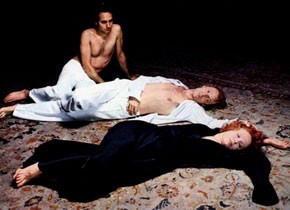Marguerite Duras
On Her Hundredth Birthday
April 11 to May 8, 2014
The piano began to play. The lights went out. Suzanne felt invisible, invincible, and she began to cry with sheer relief. It was an oasis, this dark vast room in the afternoon, the night of the lonely, the artificial and democratic night, the great egalitarian night of the cinema, more real than the actual night, more delightful and comforting than all other nights, the chosen night that is open to all ... (Marguerite Duras, 1950).
French culture knows only two artists who are equally important as both filmmakers and writers: Jean Cocteau and Marguerite Duras (1914-1996). Whereas Cocteau became a popular figure of cinema, Duras remained something of a cinephile's secret: It was widely known that she made films – almost one every year during the 1970s, her main creative period – but only a few people saw these works. This in spite of the fact that Duras had previously served a central function in several canonical and much-discussed films. As a place of longing, the cinema also played a significant role in her novels: its "artificial and democratic night" unfolded real forces of liberation.
Her entrance into filmmaking came with a bang: Duras wrote the screenplays for three major works around 1960 – Alain Resnais' Hiroshima mon amour, a key work of modernism; Peter Brook's Moderato cantabile (based on Duras' novel of the same name); as well as Henri Colpi's wonderful memory piece, Une aussi longue absence. Along with Luis Buñuel's Viridiana, the latter film won the Golden Palm in Cannes in 1961 – and is nearly forgotten today: an oeuvre maudit. Duras had already attained a certain reputation with her first post-war novel, Un barrage contre le Pacifique (1950), but she became famous for Hiroshima mon amour. With its murmuring between two people about where the other had never been and what would always remain hidden from him/her, this thoughtful excursion into a no man's land where survivors of World War II could meet scored a success with audiences of that time.
Duras was not her real name, just the first of many masks. She was born Marguerite Donnadieu in the Gia Dinh province of French Indochina. The alter-ego figures used by Duras in many variations include the names Vera Baxter, Nathalie Granger, Lol V. Stein, Aurélia Steiner and Anne-Marie Stretter. Duras uses them to play out certain aspects of her biography which includes many love stories and moments of co-dependence as well as divisive political situations. The idea of variation, a cautious circling around something that eludes being named directly, lies at the heart of her work: for example, Aurélia Steiner (1979) exists in both a Melbourne and a Vancouver variation; and Son nom de Venise dans Calcutta désert (1976) is a "reformulation" of India Song (1975) – identical soundtrack, completely different images.
Duras' prose utilizes a comparatively reduced vocabulary, and her films are mostly based on very few aesthetic choices. As a consequence, her works in both disciplines are often intertwined: the novels were subjected to fresh (cinematic) "readings," while the films gave rise to the publication of new texts, from which in turn new works for theater could be produced. A certain constant in Duras' film oeuvre is the separation of image and sound, which often also includes a separation between time and space. Stories are told, researched, discussed, and projected onto sites that often have nothing to do with the stories themselves, as in her great works Le Camion (1977) and Césarée (1978). Duras' cinema is often minimalist or "brittle" (like arte povera), but never ashamed of its modesty and nakedness – on the contrary.
At the same time, she was no stranger to the cinema of stars and stories. The main roles in her films were usually played by icons of French acting: Gérard Depardieu, Jeanne Moreau and Delphine Seyrig as well as Daniel Gélin, Dominique Sanda, Bulle Ogier and Michael Lonsdale. And Duras' last directorial work, the infinitely serene Les Enfants (1985), beautifully demonstrates that she had never lost interest in straightforward narrative cinema, which determined her beginnings as a film author: this was one possibility for her – one cinema variant among many. In work after work, Marguerite Duras tried out, and lived, these variations.
The retrospective is presented with the support of the Institut Français and includes more than 20 of Duras' directing and screenwriting works. A lecture by art historian Edith Futscher about Marguerite Duras and the cinema is also part of the exhibition.


